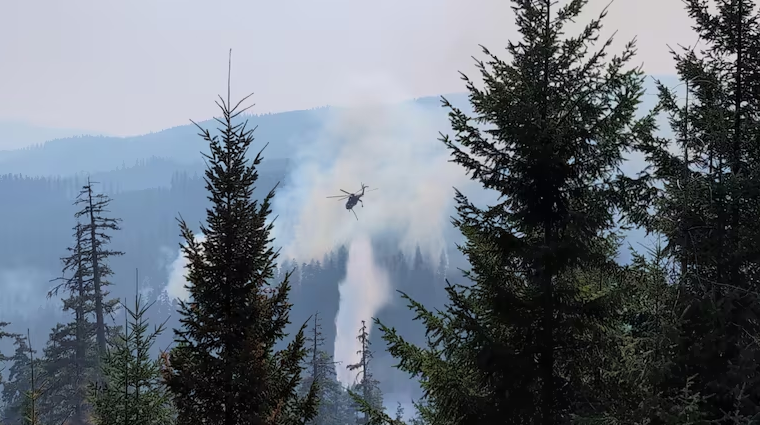A helicopter drops water on the Chalk Fire in the Willamette National Forest east of Eugene on Thursday, Sept. 5, 2024. (Cody Mosley/Willamette National Forest)
Wildland firefighters in Oregon got a reprieve thanks to cooler weather in late August and early September, but officials warn a heat wave and dry, easterly winds could fan flames or start new fires through the weekend.
“Oregon is still experiencing one of the worst seasons we’ve seen in the past decade, and the department warns the public against complacency,” the Oregon Department of Forestry wrote in a press release Thursday morning.
So far this year, more than 1.5 million acres have burned in Oregon, the most in its recorded history.
The department warns Oregonians to be cautious. Some tips for preventing wildfires include:
Don’t park your car over dry grass, and make sure your vehicle is regularly serviced to prevent overheating.
Never toss cigarette butts on the ground.
Check local restrictions before lighting a campfire.
Cover any debris piles until fire season is over. It is safer to burn debris piles during wet fall and winter conditions.
A combination of strong east winds and high temperatures fueled the catastrophic 2020 Labor Day Weekend fires across Oregon. Even so, fire officials told OPB this week’s east wind event won’t be nearly as strong.
“We want to be clear that these are not at the same level of significance or threat as what we saw several years ago,” said Joel Brumm, the spokesperson for the Whisky Creek, Sandstone and Blister Creek fires.
Those wildfires are burning in the Mount Hood National Forest. On the northern end, flames from the Whisky Creek Fire have spread up to the burn scar left by the 2017 Eagle Creek Fire. That scar has created a barrier that is preventing the Whisky Creek Fire from growing.
The fire is also burning about a dozen miles east of the Bull Run Watershed, a collection of rivers and streams that provide drinking water to about 1 million people in the Portland area. Still, Brumm said there’s little threat to the watershed.
“It would be a very rare event that would cause these fires to really pick up and leave their existing footprint,” Brumm said.
Even with the heat wave, Brumm said his team isn’t expecting these fires to grow significantly.
Still, fires in Central and Southern Oregon appear to be kicking up. The Copperfield Fire in Klamath County has burned eight homes and 19 other buildings, reports the Klamath Herald and News. Fire agencies have also added recreational closures in the Ochoco National Forest due to increased fire activity.
Although the three Mount Hood fires are relatively small compared to others in the state — their boundaries collectively cover a little over 2,100 acres — they have so far cost the U.S. Forest Service almost $39 million to suppress, according to data from the National Interagency Fire Center.
Brumm attributes the steep price tag to the general cost of fighting fires in steep, mountainous terrain, which requires more planes and helicopters to douse flames and transfer firefighting equipment to crews.
The Forest Service has so far spent $759 million fighting fires in Oregon this year. The agency spends an annual average of $2.9 billion suppressing wildfires across the country. That price is expected to rise as much as 84% by 2050, as climate change fuels bigger, more expensive wildfires.
GET THE MORNING HEADLINES DELIVERED TO YOUR INBOX

